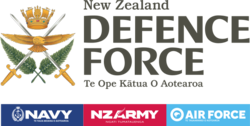New Zealand/Military
(Armed Forces) | |
|---|---|
 | |
| Parent organization | New Zealand |
| Headquarters | Wellington |
| Leader | Chief of Defence Force (New Zealand) |
| Interest of | Operation Burnham |
| Very active military despite its modest size. | |
The New Zealand Defence Force, despite its modest size, has participated in more wars since 1945 than only a handful of countries, including the Korean War, Vietnam War, Occupation of Afghanistan (2001-2019), East Timor (1999–2003, 2006), Solomon Islands (2003–2013); and smaller contingents to other conflicts, always integrated with US and UK forces. New Zealand sees itself as the military "policeman"of the smaller South Pacific nations.
Contents
Overview
New Zealand shares training facilities, personnel exchanges, and joint exercises with the Philippines, Thailand, Indonesia, Papua New Guinea, Brunei, Tonga, and South Pacific states. It exercises with its Five Power Defence Arrangements partners, Australia, the United Kingdom, Malaysia, and Singapore. New Zealand military personnel participate in training exercises, conferences and visits as part of military diplomacy.
New Zealand is a signatory of the ANZUS treaty, a defence pact between New Zealand, Australia and the United States dating from 1951. After the 1986 anti-nuclear legislation that refused access of nuclear-powered or armed vessels to ports, the USA withdrew its obligations to New Zealand under ANZUS, and ANZUS exercises are now bilateral between Australia and the United States. Under anti-nuclear legislation, any ship must declare whether it is nuclear-propelled or carrying nuclear weapons before entering New Zealand waters. Due to the US policy at that time of "neither confirm nor deny", ship visits ceased although NZ and the USA remained "good friends".[1] Despite the Presidential Directive of 27 September 1991 that removed tactical nuclear weapons from U.S. surface ships, attack submarines, and naval aircraft,[2] ship visits have not resumed. Despite signs of rapprochement in recent years, military relationships with the US remain limited.
The NZDF served alongside NATO-led forces in Afghanistan in the first decade of the twenty-first century, and in 2004 the NZSAS was awarded a Presidential Unit Citation by US President George W Bush for "extraordinary heroism" in action. In 2008 US Secretary of State Condoleezza Rice during a visit to New Zealand said "New Zealand is now a friend and an ally".[3]
New Zealand is a member of the ABCA Armies standardisation programme, the naval AUSCANNZUKUS forum, the Air and Space Interoperability Council (ASIC, the former ASCC, which, among other tasks, allocates NATO reporting names) and other Western 'Five Eyes' fora for sharing signals intelligence information and achieving interoperability with like-minded armed forces, such as The Technical Cooperation Program (TTCP).
The New Zealand government opposed and officially condemned the 2003 Invasion of Iraq. Despite this, the frigate HMNZS Te Kaha (F77) and an RNZAF P-3 Orion maritime surveillance aircraft were deployed to the Gulf, under US command.[4][5]
In February 2021, it was revealed that the New Zealand Air Force with the approval from the Ministry of Foreign Affairs had been silently assisting Saudi Arabian Navy in its hunger blockade of Yemen. Military equipment to Saudi Arabia was also exported in 2016 and 2018.[6]
Army
New Zealand's Army has 4,637 full-time and 1,778 part-time troops.[7] They are organised as light infantry and motorised infantry equipped with 102 Canadian-manufactured LAV III Light Armoured Vehicles (NZLAV). There are also armoured reconnaissance, artillery, logistic, communications, medical and intelligence elements. The New Zealand Special Air Service is the NZDF's special forces capability, which operates in both conventional warfare and counter-terrorist roles.
The Royal New Zealand Navy (RNZN) has 2,268 full-time and 543[8] part-time sailors. The RNZN possess two Anzac class frigates, developed in conjunction with Australia, based on the German MEKO 200 design. Nine other vessels are in use, consisting of patrol vessels and logistics vessels. In 2010, the RNZN completed the acquisition of seven new vessels: one large Multi-Role Vessel named HMNZS Canterbury, two Offshore Patrol Vessels, and two Inshore Patrol Vessels. All of these vessels were acquired under Project Protector, and were built to commercial, not naval, standards.
Air Force
The Royal New Zealand Air Force (RNZAF) has 2,542 full-time and 285 part-time airmen and airwomen.[7] The RNZAF consists of 51 aircraft, consisting of P-3 Orion maritime patrol aircraft and Lockheed C-130 Hercules and other transport aircraft. The NHIndustries NH90 operates in a medium-utility role, and the AgustaWestland A109 operates the light utility helicopter role, in addition to the main training platform. RNZAF primary flight training occurs in Beechcraft T-6 Texan IIs, before moving onto the Beechcraft King Air.
The RNZAF does not have air combat capabilities following the retirement without replacement of its Air Combat Force of A-4 Skyhawks in December 2001.[9][10]
References
- ↑ https://web.archive.org/web/20070930043259/http://www.stuff.co.nz/thepress/3995638a13135.html
- ↑ https://fas.org/irp/doddir/navy/opnavinst/5721_1f.pdf
- ↑ http://www.scoop.co.nz/stories/WO0807/S00761.htm
- ↑ http://www.nzherald.co.nz/nz/news/article.cfm?c_id=1&objectid=3197860
- ↑ http://www.socialistworkerarchive.net.nz/~server/Socialist_Worker_NZ_Archive/War_On_Terror_leaflets_(2001-4)_files/SWMR%20%235%20Supplement.pdf
- ↑ https://www.nzherald.co.nz/nz/the-conversation-yemen-crisis-demands-review-of-nz-military-links-with-saudi-arabia/PLBHCWUXAPAQZRXF2YWIIH6Y7Q
- ↑ a b https://www.nzdf.mil.nz/assets/publication/20-099-NZDF-Annual-Report-2020-FA-WEB.PDF
- ↑ https://www.nzdf.mil.nz/assets/publication/20-099-NZDF-Annual-Report-2020-FA-WEB.PDF
- ↑ Chapman, Paul New Zealand scraps air force warplanes May 9, 2011 The Telegraph Retrieved 23 June 2016
- ↑ RNZAF Skyhawks to become museum pieces April 8, 2011 Australian Aviation Retrieved 23 June 2016